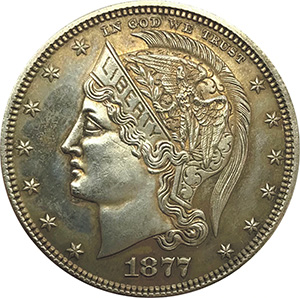Shore Collectibles
By Douglas Keefe
Patterns are used in various activities to replicate something that is to be produced multiple times. I’ve seen it done by carpenters who need to cut several boards in the same angle. After the first board is cut, they will label it “PAT” and then use it to mark the cut on the subsequent boards. Years ago, women would buy dress patterns to make their own clothing. I remember my mother buying dress patterns and cloth, laying the pattern on the cloth and cutting the pieces, then sowing the pieces together and, after a days’ work and a few dollars expense, having a brand new dress in the material she wanted.
Coin patterns are different from the above in as they are not meant to replicate a design but rather, as a definition goes they are “an experimental piece which either illustrates a proposed coinage design, or which embodies a proposed innovation of composition, size or shape”. Pattern coinage can be traced all to way back to the 1600’s where a letter from British government officials to engraver David Ramage authorized him to produce patterns of various denominations of coins for consideration of minting those coins of his designs for use in the commonwealth.

In the United States, pattern coinage has been produced from the beginning of the opening of he Philadelphia mint in 1792 which struck several “experimental” cents featuring Lady Liberty more as an actual woman (some theorize the model was Martha Washington) in copper or in a smaller size with a silver plug in the center. 1793, the first actual year of commercial production saw 3 different designs of one cent coins, the third design being used beyond that year. Were the first 2 designs patterns? Probably not because quantities were released for circulation, but the mint was experimenting.
Patterns are not only produced for changes in design for existing coins but are solicited when a different denomination is being considered. Examples being during 1850’s when the mint was proposing adding two cent and three cent coins to the production. In the case of striking an existing coin in a different metal, existing dies would be used. An example of this occurred in 1974 when the price of copper used to strike one cent coins equaled that coin’s face value. Aluminum cents were struck in the expectation that the metal would replace the copper. This did not happen and virtually all of those cents were destroyed.
Until the late 1880’s patterns of coins would find their way into the marketplace, but since that time it has been the mints’ practice to destroy all patterns. I believe that now patterns are submitted as plaster designs, much larger than an actual coin.
Patterns predating 1890 are actual die struck pieces and the quantity varies from a few to a few thousand. Some are more attractive than the design chosen and some we are glad they never saw the light of day again. However, consideration of choosing a design to become the actual coin is not only based on appearance but how well a die would be expected to hold up under continual use. For example, a design that was too close to the edge would result in a weak die that would be prone to breakage. Also, patterns were always dated the year they were minted, which could be several years before a design is chosen.
Pattern collecting is not for the average collector, but viewing examples is easy and rewarding by going online and searching “coin patterns”.
Douglas Keith is the President of Beachcomber Coins, Inc. He and his wife Linda operate Beachcomber Coins and Collectibles, formally located in the Shore Mall and now located at 6692 Black Horse Pike, Egg Harbor Township in the old Wawa building. They also have satellite offices for buying only in Brigantine (Saturday), and in Absecon (Tuesday). Between them, they have over 70 years of experience buying and selling coins, collectibles in precious metals. They are members of the American Numismatic Association, the Industry Council of Tangible Assets, the Numismatic Guarantee Corporation, the Certified Coin Exchange and the Professional Coin Grading Service. Visit their website at www.beachcombercoinsinc.com for video and information.






